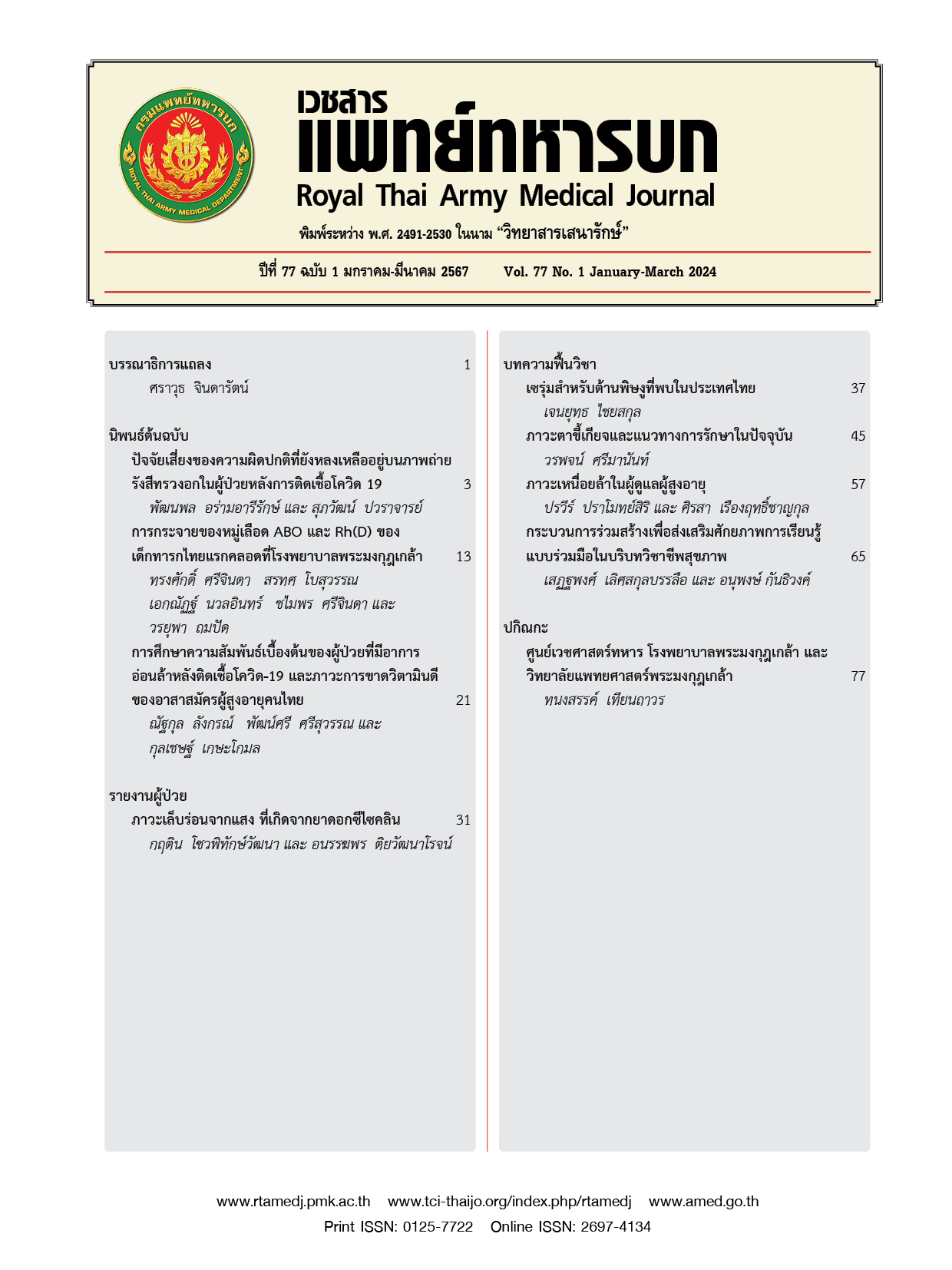ภาวะตาขี้เกียจและแนวทางการรักษาในปัจจุบัน
Main Article Content
Downloads
Article Details

อนุญาตภายใต้เงื่อนไข Creative Commons Attribution-NonCommercial-NoDerivatives 4.0 International License.
บทความในวารสารนี้อยู่ภายใต้ลิขสิทธิ์ของ กรมแพทย์ทหารบก และเผยแพร่ภายใต้สัญญาอนุญาต Creative Commons Attribution-NonCommercial-NoDerivatives 4.0 International (CC BY-NC-ND 4.0)
ท่านสามารถอ่านและใช้งานเพื่อวัตถุประสงค์ทางการศึกษา และทางวิชาการ เช่น การสอน การวิจัย หรือการอ้างอิง โดยต้องให้เครดิตอย่างเหมาะสมแก่ผู้เขียนและวารสาร
ห้ามใช้หรือแก้ไขบทความโดยไม่ได้รับอนุญาต
ข้อความที่ปรากฏในบทความเป็นความคิดเห็นของผู้เขียนเท่านั้น
ผู้เขียนเป็นผู้รับผิดชอบต่อเนื้อหาและความถูกต้องของบทความของตนอย่างเต็มที่
การนำบทความไปเผยแพร่ซ้ำในรูปแบบสาธารณะอื่นใด ต้องได้รับอนุญาตจากวารสาร
เอกสารอ้างอิง
American Academy of Ophthalmology. Basic and Clinical Science Course Vol. 6, San
Francisco, (CA): American Academy of Ophthalmology; 2021-22. 159-168 p.
American Academy of Ophthalmology. Pediatric Eye Evaluations Preferred Practice Pattern [Internet]. San Francisco, CA: American Academy of Ophthalmology;2022. [Cited 2024 Mar 31]. Available from: https://www.aao.org/preferred-practicepattern/pediatric-eye-evaluations-ppp-2022
DeSantis D. Amblyopia. Pediatr Clin North Am. 2014;61(3):505-18.
Pescosolido N, Stefanucci A, Buomprisco G, Fazio S. Amblyopia treatment strategies and new drug therapies. J Pediatr Ophthalmol Strabismus. 2014;51(2):78-86.
Jaradaroonchay M, Sakulsiritiwakorn N, Jenchitr W. Strabismus and Amblyopia in Thailand (Survey of Visual Impairment in Thailand). Proceedings of the RSU National Research Conference. 2014 Apr 3; Pathum Thani, Thai. p.143-51.
Teerawattananon K, Myint CY, Wongkittirux K, Teerawattananon Y, Chinkulkitnivat B, Orprayoon S, et al. Assessing the accuracy and feasibility of a refractive error screening program conducted by school teachers in pre-primary and primary schools in Thailand. PLoS One. 2014 ;9(6):e96684.
Tananuvat N, Worapong A, Kupat J, Manassakorm A, Pattanapitoon K, Wattananikorm S. Results of refractive error survey in school children: vision screening project. Chiang Mai Medical Bulletin. 2002;41(2):81-8. Thai.
Tananuvat N, Manassakorn A, Worapong A, Kupat J, Chuwuttayakorn J, et al. Vision screening in schoolchildren: two years results. J Med Assoc Thai. 2004;87(6):679-84.
Holmes JM, Kraker RT, Beck RW, Birch EE, Cotter SA, Everett DF, et al. Pediatric Eye Disease Investigator Group. A randomized trial of prescribed patching regimens for treatment of severe amblyopia in children. Ophthalmology. 2003;110(11):2075-87.
Repka MX, Beck RW, Holmes JM, Birch EE, Chandler DL, Cotter SA, et al. Pediatric Eye Disease Investigator Group. A randomized trial of patching regimens for treatment of moderate amblyopia in children. Arch Ophthalmol. 2003;121(5):603-11.
Repka MX, Kraker RT, Holmes JM, Summers AI, Barnhardt CN, Tien DR, et al. A randomized trial of atropine versus patching for treatment of moderate amblyopia: follow-up at 15 years of age. J AAPOS. 2014;18(4):e9.
Repka MX, Cotter SA, Beck RW, Kraker RT, Birch EE, Everett DF, et al. Pediatric Eye Disease Investigator Group. A randomized trial of atropine regimens for treatment of moderate amblyopia in children. Ophthalmology. 2004;111(11):2076-85.
PRIESTLEY BS, BYRONHM, WESELEY AC. Pleoptic methods in the management of amblyopia with eccentric fixation. Am J Ophthalmol. 1959;48:490-502.
Holmes JM, Manh VM, Lazar EL, Beck RW, Birch EE, Kraker RT, et al. Pediatric Eye Disease Investigator Group. Effect of a Binocular iPad Game vs Part-time Patching in Children Aged 5 to 12 Years With Amblyopia: A Randomized Clinical Trial. JAMA Ophthalmol. 2016:134(12):1391-400.
Manh VM, Holmes JM, Lazar EL, Kraker RT, Wallace DK, Kulp MT, et al. Pediatric Eye Disease Investigator Group. A Randomized Trial of a Binocular iPad Game Versus Part-Time Patching in Children Aged 13 to 16 Years With Amblyopia. Am J Ophthalmol. 2018 ;186:104-15.
Rastegarpour A. A computer-based anaglyphic system for the treatment of amblyopia. Clin Ophthalmol. 2011;5:1319-23.
Pediatric Eye Disease Investigator Group. A randomized trial of near versus distance activities while patching for amblyopia in children aged 3 to less than 7 years. Ophthalmology. 2008;115(11):2071-8.
Ibrahimi D, Mendiola-Santibañez JD, Cruz-Martínez E, Gómez-Espinosa A, Torres-Pacheco I. Changes in the Brain Activity and Visual Performance of Patients with Strabismus and Amblyopia after a Compete Cycle of Light Therapy. Brain Sci. 2021;11(5):657.
Yang D, Wang P, Pan Y, Zhang J, Li D, Gong W, et al. Short-term effect of dark exposure on vision in patients with amblyopia. Invest Ophthalmol Vis Sci. 2022;63(7):1230-A0338.
Pandey PK, Chaudhuri Z, Kumar M, Satyabala K, Sharma P. Effect of levodopa and carbidopa in human amblyopia. J Pediatr Ophthalmol Strabismus. 2002;39(2):81-9.
Pawar PV, Mumbare SS, Patil MS, Ramakrishnan S. Effectiveness of the addition of citicoline to patching in the treatment of amblyopia around visual maturity: a randomized controlled trial. Indian J Ophthalmol. 2014;62(2):124-9.
Pediatric Eye Disease Investigator Group; Holmes JM, Manny RE, Lazar EL, Birch EE, Kelly KR, Summers AI, et al. A Randomized Trial of Binocular Dig Rush Game Treatment for Amblyopia in Children Aged 7 to 12 Years. Ophthalmology. 2019;126(3):456-66.
Liu M, Li L, Leung PC, Wang CC, Liu M, Lan L, et al. Acupuncture for amblyopia in children. Cochrane Database Syst Rev. 2017;2017(8):CD009301.
Kim B, Kim MH, Kim J, Park S, Choi I. Acupuncture for pediatric bilateral amblyopia. Integr Med Res. 2020;9(4):100435.
Tuna AR, Pinto N, Brardo FM, Fernandes A, Nunes AF, Pato MV. Transcranial Magnetic Stimulation in Adults With Amblyopia. J Neuroophthalmol. 2020;40(2):185-92.
Sen S, Singh P, Saxena R. Management of amblyopia in pediatric patients: Current insights. Eye (Lond). 2022;36(1):44-56.
Kaur S, Sharda S, Aggarwal H, Dadeya S. Comprehensive review of amblyopia: Types and management. Indian J Ophthalmol. 2023;71(7):2677-86.
Bui Quoc E, Kulp MT, Burns JG, Thompson B. Amblyopia: A review of unmet needs, current treatment options, and emerging therapies. Surv Ophthalmol. 2023;68(3):507-25.
Papageorgiou E, Asproudis I, Maconachie G, Tsironi EE, Gottlob I. The treatment of amblyopia: current practice and emerging trends. Graefes Arch Clin Exp Ophthalmol. 2019;257(6):1061-78.


